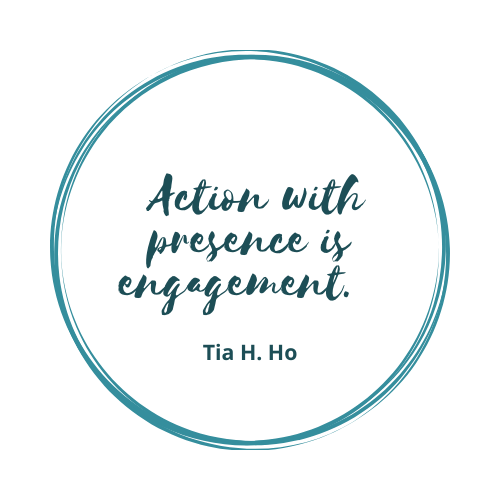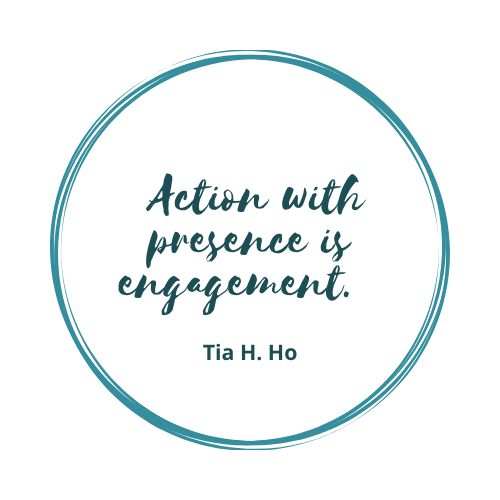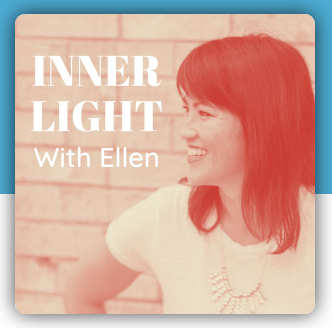Moment of Mind April 2020


Moment of Mind
Life moves you.
In mindfulness we’re using our attention as a tool to notice our moment to moment lived experience and to practice being in one of our default states, presence. This is week 4 of a 7 week Stress Supports Challenge, folded into the monthly newsletter, as we explore turning toward the human system.
Week 4 is focused on physical activity as a stress support where motion is a release, regular activity expands all of your body's systems' capacity (with other benefits discussed below), and we explore life as it moves you.
For the applied mindfulness practice I invite you to consider that moving the body is a form of life expression. The first week of this challenge was about expression. Expression is a form of release of pent-up energy that the brain-body generates as life lives it. Our brain may at times mistakenly hold a lid on that energy from social conditioning where society has told you that only some emotions or thoughts are "okay" and that it's not okay to appear certain ways. When the self concept develops in a culture of adults who say "don't feel" or "hide what you feel" or "don't move your arms like that" this gives a bizarre emphasis on natural life experiences moving through. It also conveys that worth is only granted from things outside rather than being built-in. Yet, if you've sought a relationship, or a job, or a body shape/size, or even a goal and attained it and then found "incomplete" emotions returning you can see that wholeness isn't outside of you. It's inside, already whole. And those thoughts come from a self concept that's insecurable. You were never incomplete, that's a myth.
Even the statement "this too shall pass" the brain can turn into a subtle message of "don't want this." Life encompasses all feeling and emoting states. We are designed for energy to move through, and it is a misunderstanding about how our systems function that encourages people to avoid it, to put a lid on it, and to problematize it. Thoughts and emotions and sensations are electrical biochemical impulses moving through you - that's it. At their core they are equivalent to each other, even if the mind puts judgments on some being better or worse than the other. It's life juice. Life energy. Life dust. Life essence. Life expansion. Whatever you want to call it. Moving, changing, shifting life experience. What if it was possible to appreciate all of it because your wholeness does not come from having only one emotion experience or avoiding specific emotion experiences? What if the core of who you are is not touched by any of them?
This week's activity is in three phases to support gently playing with motion. You can choose only one of these, try all three, or make up a new combo based on what you hear in this email.
Phase 1 - I invite you to notice when you do something without thinking about it. Maybe it's sitting up in bed in the morning, going to the bathroom, or going from one room to the next and not remembering why. When you notice this happening see if you can identify any thoughts in your mind, any sensations in your body or emotions you are experiencing. If there aren't any - notice that. How did that just happen if you didn't tell your body to do it? What if life moves you in the same way that life grows a plant, develops a child into an adult, and flaps a bird's wings? What if this is where thought, feeling and sensation come from?
Phase 2 - I invite you to intentionally move your arm or the body in some specific way. Do you have to physically tell the arm or body to move? Are there thoughts in your mind, or sensations or emotions you are experiencing? See if you can slow it way down to notice.
Phase 3 - I invite you to find 5 minutes and do whatever activity occurs to you that gets your heart rate up (unless your doctor has told you not to do this, listen to them). It could be walking around the block, dancing to a song in your kitchen, chasing after your child, jumping jacks, walking up and down the 3 stairs of your building, vacuuming, or even arm circles. Whatever sounds interesting and do-able for five minutes. You can set a timer. Use the five minutes as an activity where you turn toward your experience. Does your body move even if your mind is worrying about something in the future? As your body's heart rate increases and then decreases can you feel that the sensations change?
I would love to hear what you notice!
Love For Your Inner Science Nerd
What Exercise Actually Does
One thing I love about research is that it's never done. There's always more to learn and discover. In 2017 a group of researchers summarized the current literature on exercise and its relationship to mental health. Mikkelsen (2017) and her colleagues found that exercise affects positive mood states based on three core pathways including biochemical/immunological, physiological, and psychological mechanisms.
Positive mood is what researchers call "affect", which we talked about in February's newsletter. This is what we often call "feelings" which are sensations coming from the body that is one of four ingredients the brain uses to generate emotions. So you may feel both pleasant and activated for the brain to generate the emotion "happy." And you may feel both unpleasant and low energy for the brain to generate the emotion "sad." You can also feel many emotions at the same time just like your body can have a mix of fluctuating physiological states.
Researchers differentiate physical activity from exercise. Physical activity is bodily movement in the skeletal muscles (muscles around your bones) which expends energy - like what we talked about in the section above. Impromptu dancing, orgasms, the random jog to catch the bus, and even shivering are all forms of physical activity.
Exercise is "planned, structured, repetitive and purposive in the sense of improvement or maintenance of one or more components of physical fitness" (Casperson, 1985). Mikkelsen and colleagues note that fitness is related to health gains such as cardiorespiratory endurance, flexibility, or muscular strength and skills are gains such as agility, balance, speed, reaction time, coordination, etc. There are studies that indicate health-focused aerobic activities, like a brisk walk, have just as many mental health benefits as non-aerobic activities focused on skill such as qi-gong, yoga, or tai-chi. So they looked at all of it.
First, researchers found that exercise improves immune system and biochemical functioning that results in lowering chronic inflammation which impacts mood states (Mikkelsen, 2017). This relates to the immune system's ability to accurately detect microbial pathogens and not attack parts of the body in various inflammatory diseases like lupus, asthma, rheumatoid arthritis and others. It also reduces a build up of tiny proteins that are related to people who experience chronic depression. And it increases the vagus nerve strength and tone which is the main connector between the brain and body that regulates all of your metabolic functioning. There's a caveat: people who engage in prolonged periods of strenuous exercise (competitive ultra-endurance running for example) that level of exercise can temporarily suppress immune system functioning, increasing inflammation and making elite athletes more susceptible to, for example, upper respiratory infections. Not relevant to the rest of us, just pointing out that there are extremes where you stop getting benefits.
Second, researchers found that exercise changes the body's physiology which affects mood states (Mikkelsen, 2017). They have different hypotheses about why this happens, and they're not sure which one can explain this the most, or most consistently, for whom. One hypothesis is that this happens through releasing endorphins ("runners high"). Endorphins are used by the body to endure pain and relate to euphoria and sedation. The second hypothesis is that exercise raises your core body temperature which can reduce anxiety through reducing muscle tension (oh hey, there's that energy release again). Jury is out on that idea as different studies found an effect and others found no relationship.
A third, well-documented, hypothesis is that exercise increases mitochondrial functioning. Mitochondria do all kinds of fun things in the cells of your tissues and muscles, especially in your brain. Your neurons have a LOT of mitochondria to keep all that intrinsic brain functioning you have going. One of the things they do is regulate neuroplasticity - meaning your neurons in your brain's neural networks actually function and grow better with regular exercise. The fourth hypothesis is that exercise activates a type of protein enzyme (called a kinase) that affects neurological development and aging. So when we exercise more we get more of this kinase (called mammalian target of rapamycin or mTOR which sounds like a fantasy character to me) which has antidepressant effects and improves cognition. The fifth hypothesis is that exercise acts like an antidepressant because balances neurotransmitters like serotonin, dopamine, tryptophan, glutamate, and noradrenaline. The sixth and last physiologic hypothesis is that exercise reduces stress reactivity in the part of your brain that sends alerts to your body to adapt to physical and psychological stressors. Meaning your capacity for adapting to stress increases.
The third and final thing they found is that exercise affects psychological mechanisms that impact mood states (Mikkelsen, 2017). Exercise distracts the mind, giving people a "time out' from negative and worrying thoughts. It also can give some people a sense of accomplishment as part of self-regulation. This last set of findings is the most interesting to me because it sounds like when we exercise we stop being in our heads. The other two major findings indicate that exercise changes the body's functioning in such a way that the body stops sending the same signals to the brain that it would use as part of creating low affect. When you start layering how attention goes into other senses this gets even more intriguing. Multiple studies found that distraction was more pronounced if people listened to music while exercising. And research on being in nature, particularly hiking in nature, finds a causal link between being active outdoors and reducing negative self-focused thinking (Bratman et al 2015).
What I think is going on here is that exercise, like the other supports we're exploring in the Stress Support challenge, help stabilize and support the brain-body system, and at the same time these supports are connected to when your mind settles. When our mind settles we feel better. It actually settles on its own, you don't need these support to make that happen. However the fact that some of these result in a settled mind with more consistency can help you tune in and explore. I think it's important for people to understand how this human system functions. When you start exploring how it functions you get to see the wisdom built into you. I want people to be whisperers of their own human systems - to be able to work with it instead of against it. Stay tuned for more on that next month.
Sources:
Mikkelsen, K., Stojanovska, L., Polenakovic, M., Bosevski, M., and V. Apostolopoulos (2017). Exercise and mental health, Maturitas, 106, 48-56.
S.K. Drexler, B.M. Foxwell, The role of toll-like receptors in chronic inflammation, Int. J. Biochem. Cell Biol. 42 (4) (2010) 506–518.
C.J. Caspersen, K.E. Powell, G.M. Christenson, Physical activity, exercise, and physical fitness: definitions and distinctions for health-related research, Public Health Rep. 100 (2) (1985) 126–131.
Bratman, G.N., Hamilton, J.P., Hahn, K.S., Daily, G.C. and J.J. Gross (2015) Nature experience reduces rumination and subgenual prefrontal cortex activation, PNAS, 112 (28), 8567-8572.
Get Your Park Groove On

If you haven't yet visited yet visited Powell Butte in Multnomah County, Oregon, I recommend it for a way to visit multiple habitats including hawthorne grassland, mixed fir forest, a cedar grove, and riparian zones along a creek. While I have been there many times, I visited recently during Covid19 physical distancing requirements on a weekday and was grateful at how few people were there and that those who were there all respected physical distancing.
The benefits of this park beyond it's lovely ecosystems are its accessibility and parking. This is one park that I include in my nature-based mindfulness walks for the general public because those who use mobility aids can take a nice walk to the top view using the paved paths, although they do have an incline. There are multiple times I visit when a van of individuals who have various disabilities arrive to explore the park on organized trips. There is one primary parking lot that is a gravelled lot with access to restrooms.

| I invite you to give a new podcast (click on image to the left, or this link) a listen. I was honored and delighted to talk with my friend and colleague Ellen Wyoming Deloy for her new podcast series, Inner Light With Ellen. I recommend subscribing and if you're curious about our chat it was on topics similar to this newsletter - she particularly wanted to revisit the blue sky metaphor that we talked about back in February. I know Ellen will continue to have guests on that support listeners in connecting to their own inner light. |
Image of femme-presenting person smiling with brick wall background, Words "Inner Light with Ellen" to the left of her image
| Copyright © 2019-2020, Finding Mindful Now LLC, All rights reserved. www.findingmindfunow.com, full newsletter with current offers originally published on MailChimp |
